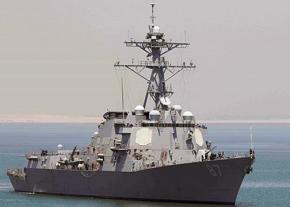U.S. steps up its role in Saudi war on Yemen
A missile strike in Yemen from a U.S. warship is a sign of further escalation in another one of the U.S. government's many wars in the Middle East, explains .
WHEN A U.S. Navy destroyer fired cruise missiles on October 13 at rebels who have controlled Yemen's capital since 2014, the New York Times described the attack as "the first time the United States has become involved militarily" in the conflict.
The following day, the Times continued building on this false framework for understanding the dynamic of the conflict in Yemen with the following lead to its article: "For the United States, it was simple retaliation: Rebels in Yemen had fired missiles at an American warship twice in four days, and so the United States hit back, destroying rebel radar facilities with missiles."
But the idea that the U.S. only entered directly into the war on Yemen in mid-October in reaction to unprovoked attacks on its warships is absurd.
FIRST, THE Pentagon itself acknowledged that U.S. officials weren't sure who had fired on the U.S. ships. Houthi rebel forces, an indigenous Shia group with loose ties to Iran, denied that the missiles were launched from within their territory.

Second, the U.S. has been waging a drone war in Yemen since 2002, carrying out its policy of anonymous-assassination-from-the-sky with increasing frequency since 2011. To date, U.S. drone strikes have killed between 65 and 101 civilians and injured many more. Unconfirmed drone strikes and U.S. military operations have likely killed hundreds more. In 2015, the UN reported that U.S. drone strikes killed more Yemeni civilians than al-Qaeda had.
Third, the U.S. is the chief backer of Saudi Arabia--over many decades in general, as well as specifically in its scorched-earth war against the Houthis launched in 2015. The U.S. has provided targeting intelligence, refueled Saudi fighter planes attacking rebel positions and recently signed a $1.15 billion arms deal with Saudi Arabia. According to Reuters:
Since March 2015, Washington has authorized more than $22.2 billion in weapons sales to Riyadh, much of it yet to be delivered. That includes a $1.29 billion sale of precision munitions announced in November 2015 and specifically meant to replenish stocks used in Yemen.
Just days before the missiles were fired at the U.S. ships--and landed harmlessly in the water--Saudi warplanes attacked a funeral in Sana, killing more than 140 people. Such indiscriminate targeting of civilians is precisely the reason that some U.S. officials warned last year--in other words, before the Obama administration approved the last mammoth arms deal--that further U.S. support for Saudi Arabia's war in Yemen could implicate U.S. forces in war crimes.
According to the Guardian, "More than one-third of all Saudi-led air raids on Yemen have hit civilian sites, such as school buildings, hospitals, markets, mosques and economic infrastructure, according to the most comprehensive survey of the conflict."
But the warnings by U.S. legal analysts, unearthed by Reuters under the Freedom of Information Act, were ignored as the administration sought to use arm shipments to purchase Saudi favor at a time when the U.S. was trying to finalize a nuclear deal with Iran that Saudi Arabia opposed.
IF THE Houthi rebels had fired missiles at U.S. warships anchored in Boston Harbor, the media's narrative might have a distant resemblance to reality. But the U.S. parked its destroyers off the coast of Yemen, helping to enforce a naval blockade while also safeguarding a narrow sea-lane through which 4 million barrels of oil are transported daily.
While most of the world's attention, especially in the West, is focused on Russia's murderous siege and assault in Aleppo, Saudi Arabia and the U.S. are carrying out a similar policy in Yemen.
For more than a year, humanitarian aid organizations and human rights defenders have been sounding the alarm about famine conditions in Yemen. According to the United Nations, 14 million--half of Yemen's population--are "food insecure," and 7 million of those are "extremely food insecure," which basically means starving.
So far, some 10,000 people have died directly as a result of the war with Saudi Arabia, and the total death toll, including those who have died of lack of proper medical care, lack of electricity, increased susceptibility to disease and other indirect causes is double that amount.
So long as the U.S. continues to escalate its military involvement in the Middle East--from Yemen to Iraq to Syria--the world will become an even more dangerous, unstable and deadly place, with the growing likelihood of an inter-imperialist confrontation between the U.S.-Saudi bloc and its proxies and the Russia-Iran bloc and its proxies.


